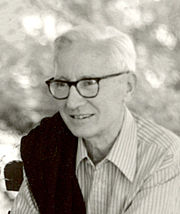Niko Tinbergen's Human Design Chart
5/1 Sacral GeneratorDutch-British biologist and ornithologist who shared the 1973 Nobel Prize in Physiology or Medicine with Karl von Frisch and Konrad Lorenz, for their discoveries concerning organization and elicitation of individual and social behaviour patterns in animals.
He was the third of the five children of Dr. Dirk Cornelis Tinbergen (8 May 1874, Den Haag – 12 Febr 1951, Den Haag), a teacher of Dutch letters at the gymnasium and Jeanette van Eek (30 April 1877 – 10 Sept 1960, Den Haag), a Remonstrant teacher. All children were very intelligent and got an academic degree, three of them became professor and Niko and Jan were awarded the Noble prize: Jan Tinbergen in 1969 for economics and Niko for Physiology and Medicine in 1973. Their youngest brother, Luuk Tinbergen (7 September 1915, Den Haag – 1 September 1955, Groningen), was a professor in ornithology and ecology in Groningen.
The very energetic Niko liked outdoor sports like skating and hiking and played hockey in the National Dutch youth team. At school he just performed well enough to prevent sacking. He disliked the perspective to study further at a boring University, but a house friend of the family, Paul Ehrenfest, introduced him to professor Thienemann, a biologist and ornithologist. In 1925, he was allowed to travel with the nature photographer Rudy Steinert to the sand-dunes near Kalinigrad in Russia to watch the birds and decided to study biology. Again during his study, he did only the necessary things, but when he became engaged, he became more serious and decided to graduate after finishing his study (12 DEc 1930). His subject was the homing behaviour of the European beewolf, more specifically how the bee could find his hole. On 12 April 1932 he dissertated with “Über die Orientierung von Philanthus triangulum, Fabr” in Leiden.
Two days later, he married in Utrecht, the chemist Lies Rutten, the daughter of the geologist L.M.R. Rutten. Several months later they travelled to Greenland to study birds. End 1933 he became am member of the staff of the Zoology Lab in Utrecht under C.J. van der Klaauw. November 1936, he met the ethologist Konrad Lorenz. They became friends and Tinbergen adopted part of his ideas on ethology to explain his filed experiments with animals. In 1940 he became a lector in Leiden.
From 9 September 1942 till 11 September 1944, Tinbergen was kept hostage in Sint-Michelsgestel. Here he wrote a children’s book “Kleew, the story of a gull” (1947). He more an more wrote in English and erected the scientific periodical the Behaviour (1948). In 1947 he became professor in experimental zoology in Leiden, but in 1949 he decided to to become a lector of the Zoology Department of Oxford. He became the head of the Animal Behaviour Group, in 1966 also professor at Oxford. Several of his Oxford graduate students became prominent biologists: Richard Dawkins, Marian Dawkins, Desmond Morris and Iain Douglas Hamilton.
When his very intelligent brother and professor in ornithology in Groningen Luuk Tinbergen committed suicide (1955), he became very depressed. It was the attachment theorist and psychiatrist John Bowbly (26 February 1907, Londen – 2 September 1990, Skye) who helped him to overcome this.
His 1973 Nobel Prize lecture dealt with the problems of autism.
Tinbergen died on 21 December 1988, after suffering a stroke at his home in Oxford, England.
Link to Wikipedia
Discover More Famous People
Browse and analyze over 55,000 public figures and celebrities.
Ra Uru Hu
5/1 Manifestor
Martha Stewart
4/6 Manifestor
David Lynch
4/6 Generator
Barack Obama
6/2 Projector
Steve Jobs
6/3 Generator
Vladimir Putin
5/1 Manifestor
Kim Kardashian
3/5 Generator
Michael Jackson
1/3 Projector
Marilyn Monroe
6/2 Projector
Ariana Grande
2/4 Projector
Oprah Winfrey
2/4 Generator
Johnny Depp
2/4 ManifestorWhat is HumanDesign.ai and how does it work?
Curious what makes Niko Tinbergen tick? HumanDesign.ai instantly maps their exact birth data into a fully interactive clickable bodygraph chart, letting you hover or tap every center, channel, and gate for plain-language explanations. Bella, the platform’s built-in AI guide, adds context in real time, translating complex mechanics into everyday insights so you can see how Niko Tinbergen’s strengths, challenges, and life themes play out on-screen.
The same tools are waiting for you. Generate your own Human Design Chart in seconds, open a library of 2000+ suggested questions, and chat with Bella as often as you like to decode your design, daily transits, and even relationship dynamics.
Want to compare energies? Save unlimited charts for friends, family, or clients, then ask Bella to reveal compatibilities, composite patterns, or coaching tips, all in one conversation thread.
Start free with core features, or unlock our Personal and Pro plans for deeper dives: unlimited Q&A, celebrity chart search spanning 55,000+ public figures, white-label PDF reports, branded content generation, and a professional profile with built-in booking for practitioners. Whether you’re exploring your own potential or guiding others, HumanDesign.ai delivers an ever-expanding toolbox of AI-powered insights—no spreadsheets, no jargon, just clarity at your fingertips.
Ready to see yours? Signup for FREE today!

